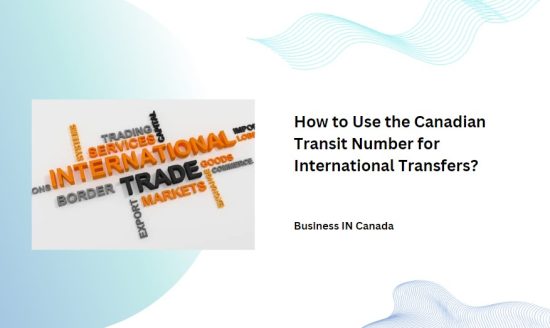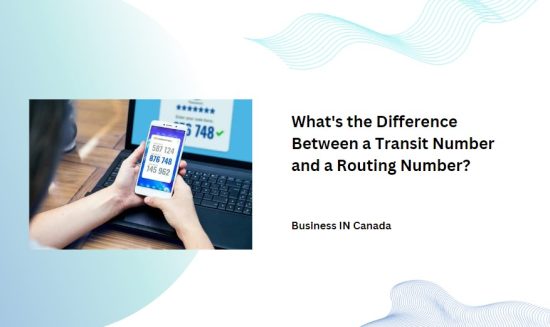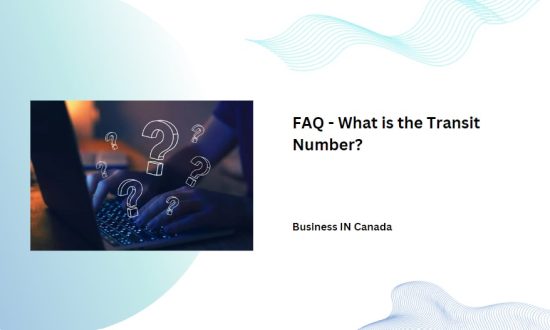If you are a Canadian who frequently sends and receives money, then you may have come across the term “transit number” at some point. But what exactly is it? How does it work? And why is it important for your financial transactions? In this blog post, we will dive into the world of transit numbers in Canada and answer all your burning questions about this essential banking tool.
From how to find your transit number on a cheque to using it for international transfers, we’ve got you covered! So buckle up, and let’s explore the fascinating world of Canadian transit numbers together!
What is the Transit Number?
The transit number is a unique nine-digit code that identifies a specific financial institution in Canada. It is also commonly referred to as the “bank routing number” or “institutional ID.” Each bank and credit union in Canada has its unique transit number, used to identify transactions made through their accounts.
When you send money from your account to another person’s account, the transit number ensures that the funds are directed to the correct destination. Similarly, when someone sends money to your account, they need your transit number along with your account information. This ensures that the funds are deposited into your correct account at the right financial institution.
Without a valid transit number, it would be impossible for banks and other financial institutions to process electronic transactions accurately and efficiently. Therefore, if you want all of your financial transactions processed correctly without any hiccups or delays, understanding what a Canadian transit number is should be on top of your priority list!
How Does Transit Number Work?

The transit number, also known as the branch transit number or financial institution routing number, is a unique 5-digit code used by Canadian banks to identify specific branches. So how does it work? Each bank in Canada is assigned a unique 3-digit institution number, which is followed by its own unique 5-digit branch/transit number. This combination of numbers helps ensure that all transactions are processed accurately and quickly.
When you provide your bank account information for electronic transfers or direct deposits/withdrawals, you will need to include your transit number along with your account number. This allows the transaction to be routed directly to the correct branch of your bank.
It’s important to note that each individual banking institution assigns its own transit numbers – there is no universal system for assigning these codes. Therefore, ensuring you have the correct transit number for your specific branch when making any transaction involving your bank account is crucial.
What is the Canadian Transit Number Used for?
The Canadian Transit Number, also known as the Bank/Branch Transit Number, is a nine-digit number used to identify financial institutions within Canada. This unique identifier plays an important role in processing electronic transactions between banks and other financial institutions.
When you initiate a transfer of funds from one bank account to another in Canada, it’s necessary to provide your bank with the recipient’s transit number, account number, and name. The transit number ensures that the transaction is accurately directed to the correct branch of the recipient’s bank.
Aside from facilitating domestic transfers, Canadian Transit Numbers are also used for international wire transfers. When sending money abroad through your Canadian bank account, you’ll need to provide your bank with both your own institution’s transit number and that of the receiving foreign bank.
Banks can quickly and accurately process payments using these transit numbers during electronic banking transactions while minimizing errors or delays.
How to Use the Canadian Transit Number for International Transfers?

If you need to make an international transfer to a bank account in Canada, it is important to have the correct transit number. Using the wrong transit number could delay or even reject your transfer. To use the Canadian Transit Number for international transfers, you will first need to gather all relevant information, including the recipient’s name and address, bank name and branch location, and transit number.
Next, you should confirm with your bank that they can send money internationally and inquire about any fees associated with this type of transaction. Your bank may also require additional information, such as SWIFT codes or IBAN numbers.
Once you have gathered all necessary information and confirmed with both banks involved in the transaction, you can initiate the transfer using your online banking portal or by visiting a local branch office. It is important to note that international transfers can take several business days to process depending on factors such as currency conversions and time zone differences between countries.
How to Find a Transit Number on a Cheque?
If you need to find your transit number in Canada, looking at one of your cheques is the easiest way. The transit number is typically printed on the bottom left-hand side of each cheque. To locate your transit number, take a look at the series of numbers printed along the bottom edge of your cheque. You should see three numbers separated by symbols resembling colons or dashes.
The first set of numbers represents your bank’s routing or institution number, while the second set identifies your specific branch location. The third set usually comprises five digits and denotes your unique account number. Between these two sets lies another set which consists of only three digits – this is known as the Transit Number for Canadian banks.
It’s important to note that not all financial institutions print their transit numbers in exactly the same place on their cheques – some may put them directly after the institution or routing number, while others may separate it with a slash symbol (e.g., 12345/678). Remember that when entering this information for online transactions, ensure you input it accurately and double-check before submitting payment!
What’s the Difference Between a Transit Number and a Routing Number?

The transit number and routing number are both used in banking transactions, but there are some key differences between the two. The transit number is a five-digit code that identifies a specific bank branch in Canada, while the routing number is a nine-digit code used by banks in the United States.
One of the main differences between these numbers is their length. The transit number has only five digits, making it much shorter than the routing number, which has nine digits.
Another difference is how they are used for international transfers. When sending money internationally from Canada, you will need to use a SWIFT or IBAN code instead of your transit number. However, when sending money from the US, you will need to use your routing number.
It’s also important to note that each bank has its own unique set of numbers for identifying branches and processing transactions. As such, it’s crucial to double-check with your bank before initiating any financial transaction. While both transit and routing numbers play an important role in banking transactions, they differ greatly depending on location and purpose.
Conclusion
When it comes to understanding the Canadian Transit Number, there are a few key points that you should keep in mind. First and foremost, this number is used by financial institutions to identify specific branches within their network. It plays an important role in ensuring that money is transferred quickly and accurately between accounts.
One thing to note about transit numbers is that they can vary depending on the bank or credit union you are dealing with. While many banks have standard formats for their transit numbers, some variations may vary from institution to institution.
FAQ – What is the Transit Number?

How do I find my transit number Canada?
Finding your Transit Number in Canada is relatively easy if you know where to look. One way to find it is by checking your bank statement or online banking profile. The Transit Number will usually be listed alongside your account number and branch address. If you have a chequebook, another way to locate the Transit Number is by looking at the bottom of one of your cheques. The nine-digit code that appears just before your account number represents the Transit Number.
You can also contact your bank’s customer service hotline or visit a local branch for assistance in finding your Transit Number. Some banks may even offer self-service options through their website or mobile app, making it convenient for customers who prefer digital channels.
It’s important to note that each financial institution has unique identifying numbers, so double-check that you have the correct information before conducting any transactions involving money transfers or deposits.
What is a 5 digit transit number in Canada?
A 5-digit transit number in Canada is a numerical code that identifies a specific bank branch. It’s part of the Canadian Payments Association (CPA) routing system and is used for domestic transactions only.
Each bank branch in Canada has its own unique five-digit transit number, which can be found on the bottom of your cheques or online banking information. This number is essential for transferring funds between banks and even within branches of the same bank.
You’ll need their transit, institution, and account numbers when making an electronic transfer to someone else’s account. The transit number should be entered correctly to ensure the funds reach their intended destination without delays or errors. It’s important to note that the 5-digit transit numbers are different from routing numbers used by US banks, but they serve similar functions. In Canada, it’s common practice to refer to both institution numbers and transit codes as “transit numbers.”
Knowing your bank branch’s five-digit code can be useful when receiving electronic transfers since some businesses may require this information before issuing payments through direct deposit.
What is TD transit code?
The TD transit code is a 5-digit number representing the specific TD Canada Trust branch where an account was opened. It’s used to identify and route transactions within the bank, making it easier for customers to conduct their financial affairs. The institutional code for TD is 0004.
Is Canada transit number the branch number?
Many people confuse the transit number with the branch number when it comes to Canadian banking. However, it is important to note that these two numbers are not the same. The transit number represents the financial institution where your account is held, while the branch number identifies the specific branch of that institution where you opened your account.
In essence, every financial institution has its own unique transit number, which remains constant for all branches across Canada, while each individual branch has its own distinct branch code appended to this transit code. Therefore, if you need to provide someone with your bank details and they ask for a “branch number,” clarify whether they mean your specific branch code or simply your bank’s generic transit number.
Whose transit number is 003 Canada?
The transit number is an essential part of banking in Canada. It helps to identify and route transactions to the correct branch. Canadian financial institutions use this number for both domestic and international transactions, making it an integral part of any transaction. As for whose transit number is 003 Canada? The answer is that it belongs to the Royal Bank of Canada.










